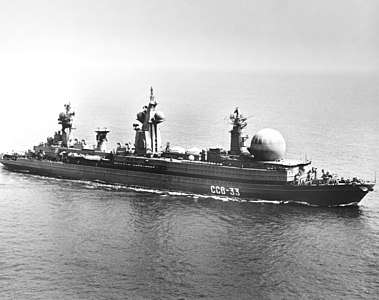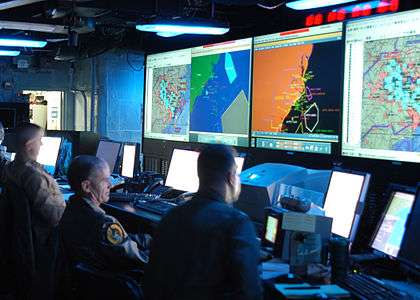Command and control
Command and control (C2) is a "set of organizational and technical attributes and processes ... [that] employs human, physical, and information resources to solve problems and accomplish missions" to achieve the goals of an organization or enterprise, according to a 2015 definition by military scientists Marius Vassiliou, David S. Alberts and Jonathan R. Agre,[1][2] The term often refers to a military system.

| Part of a series on |
| War |
|---|
|
|
|
Related
|
Versions of the United States Army Field Manual 3-0 circulated circa 1999 define C2 in a military organization as the exercise of authority and direction by a properly designated commanding officer over assigned and attached forces in the accomplishment of a mission.[3][4]
A 1988 NATO definition is that command and control is the exercise of authority and direction by a properly designated individual over assigned resources in the accomplishment of a common goal.[5] An Australian Defence Force definition, similar to that of NATO, emphasises that C2 is the system empowering designated personnel to exercise lawful authority and direction over assigned forces for the accomplishment of missions and tasks.[6] (The Australian doctrine goes on to state: The use of agreed terminology and definitions is fundamental to any C2 system and the development of joint doctrine and procedures. The definitions in the following paragraphs have some agreement internationally, although not every potential ally will use the terms with exactly the same meaning.[6])
Overview
US perspective
The US Department of Defense Dictionary of Military and Associated Terms[7] defines command and control as: "The exercise of authority and direction by a properly designated commander over assigned and attached forces in the accomplishment of the mission. Also called C2. Source: JP 1".[8]
The edition of the Dictionary "As Amended Through April 2010" elaborates, "Command and control functions are performed through an arrangement of personnel, equipment, communications, facilities, and procedures employed by a commander in planning, directing, coordinating, and controlling forces and operations in the accomplishment of the mission."[9] However, this sentence is missing from the "command and control" entry for the edition "As Amended Through 15 August 2014."[10]
Commanding officers are assisted in executing these tasks by specialized staff officers and enlisted personnel. These military staff are a group of officers and enlisted personnel that provides a bi-directional flow of information between a commanding officer and subordinate military units.
The purpose of a military staff is mainly that of providing accurate, timely information which by category represents information on which command decisions are based. The key application is that of decisions that effectively manage unit resources. While information flow toward the commander is a priority, information that is useful or contingent in nature is communicated to lower staffs and units.
Computer security industry
This term is also in common use within the computer security industry and in the context of cyberwarfare. Here the term refers to the influence an attacker has over a compromised computer system that they control. For example, a valid usage of the term is to say that attackers use "command and control infrastructure" to issue "command and control instructions" to their victims. Advanced analysis of command and control methodologies can be used to identify attackers, associate attacks, and disrupt ongoing malicious activity.[11]
Derivative terms
There are a plethora of derivative terms which emphasise different aspects, uses and sub-domains of C2. These terms come with a plethora of associated abbreviations – for example, in addition to C2, command and control is also often abbreviated as C2, and sometimes as C&C.
.jpg)
Command and control have been coupled with
- Communication / Communications
- (Military) Intelligence
- Information / Information Systems
- Computers / Computing[12]
- Surveillance
- Target acquisition
- Reconnaissance
- Interoperability
- Collaboration
- Electronic warfare
and others.
Some of the more common variations include:
- C2I – Command, Control & Intelligence
- C2I – Command, Control & Information (A less common usage)[13]
- C2IS – Command and Control Information Systems
- C2ISR – C2I plus Surveillance and Reconnaissance
- C2ISTAR – C2 plus ISTAR (Intelligence, Surveillance, Target Acquisition, and Reconnaissance)
- C3 – Command, Control & Communication (Human activity focus)
- C3 – Command, Control & Communications (Technology focus)
- C3 – Consultation, Command, and Control [NATO]
- C3I – 4 possibilities; the most common is Command, Control, Communications and Intelligence
- C3ISTAR – C3 plus ISTAR
- C3ISREW – C2ISR plus Communications plus Electronic Warfare (Technology focus)
- C3/SA - C3 plus Situational Awareness
- C4, C4I, C4ISR, C4ISTAR, C4ISREW, C4ISTAREW – plus Computers (Technology focus) or Computing (Human activity focus)[14][15]
- C4I2 – Command, Control, Communications, Computers, Intelligence, and Interoperability
- C5I – Command, Control, Communications, Computers, Collaboration and Intelligence
- C6ISR – Command, Control, Communications, Computers, Cyber-Defense and Combat Systems and Intelligence, Surveillance, and Reconnaissance[16]
- NC2 − Nuclear command and control
- NC3 − Nuclear command and control and communications
and others.
- Command: The exercise of authority based upon certain knowledge to attain an objective.
- Control: The process of verifying and correcting activity such that the objective or goal of command is accomplished.
- Communication: Ability to exercise the necessary liaison to exercise effective command between tactical or strategic units to command.
- Computers: The computer systems and compatibility of computer systems. Also includes data processing.
- Intelligence: Includes collection as well as analysis and distribution of information.
Command and control centers
 The Soviet nuclear-powered command and control naval ship SSV-33 Ural in the year 1988.
The Soviet nuclear-powered command and control naval ship SSV-33 Ural in the year 1988. Joint Operations Center watch standers aboard the command ship USS Mount Whitney in the year 2005.
Joint Operations Center watch standers aboard the command ship USS Mount Whitney in the year 2005.
A command and control center is typically a secure room or building in a government, military or prison facility that operates as the agency's dispatch center, surveillance monitoring center, coordination office and alarm monitoring center all in one. Command and control centers are operated by a government or municipal agency.
Various branches of the US military such as the US Coast Guard and Navy have command and control centers. They are also common in many large correctional facilities.
A command and control center that is used by a military unit in a deployed location is usually called a "command post".[17] A warship has a Combat Information Center for tactical control of the ship's resources, but commanding a fleet or joint operation requires additional space for commanders and staff plus C4I facilities provided on a Flagship (e.g., aircraft carriers), sometimes a Command ship or upgraded logistics ship such as USS Coronado.
Command and control warfare
Command and control warfare encompasses all the military tactics that use communications technology. It can be abbreviated as C2W. An older name for these tactics is "signals warfare", derived from the name given to communications by the military. Newer names include information operations and information warfare.
The following techniques are combined:
- Operations security (OPSEC)
- Military deception
- Psychological operations (PSYOP)
- Electronic warfare (EW)
- Psychological warfare
- Cyber Operations
with the physical destruction of enemy communications facilities. The objective is to deny information to the enemy and so disrupt its command and control capabilities. At the same time precautions are taken to protect friendly command and control capabilities against retaliation.
In addition to targeting the enemy's command and control, information warfare can be directed to the enemy's politicians and other civilian communications.
See also
- Battlespace
- Battle command
- Civilian control of the military
- Command and control warfare
- Command center
- Command ship
- Communications protection
- Defence Information Infrastructure
- Electronic warfare
- Fingerspitzengefühl
- Fog of war
- Intent (military)
- International Command and Control Research and Technology Symposium
- Military communications
- Mission Command
- Mission-type tactics
- Network-centric warfare
- Reconnaissance, surveillance, and target acquisition (RSTA)
- Signal Corps (disambiguation)
- Signals intelligence (SIGINT)
- Surveillance and Target Acquisition (STA)
US and other NATO specific:
- 505th Command and Control Wing
- Command and Control Research Program (CCRP)
- Deployable Joint Command and Control
- Future Combat Systems Command and Control Vehicle
- Global Command and Control System
- Joint Force Air Component Headquarters
- Joint Interoperability of Tactical Command and Control Systems
- National Command Authority
- NATO Communications and Information Systems Agency
- NATO Consultation, Command and Control Agency
- NORAD
- Worldwide Military Command and Control System
Other
- Kiev Military Institute of Control and Signals
References
Citations
- Vassiliou, Marius, David S. Alberts, and Jonathan R. Agre (2015). C2 Re-Envisioned: the Future of the Enterprise. CRC Press; New York; p. 1, ISBN 9781466595804.
- See also Ross Pigeau; Carol McCann (Spring 2002). "Re-conceptualizing Command and Control" (PDF). Canadian Military Journal. 3 (1): 53–63. Archived (PDF) from the original on 20 November 2013. Retrieved 1 March 2014.
- para 5-2, United States Army Field Manual: FM 3–0
Headquarters, Department of the Army (14 June 2001). FM 3–0, Operations. Washington, DC: GPO. OCLC 50597897. Archived from the original (PDF inside ZIP–SFX) on 19 February 2002. Retrieved 19 August 2013.
Newer versions of FM 3-0 Archived 4 March 2016 at the Wayback Machine do not define Command and control, even though they use the term extensively. - Builder, Carl H., Bankes, Steven C., Nordin, Richard, "Command Concepts – A Theory Derived from the Practice of Command and Control" Archived 2 October 2012 at the Wayback Machine, MR775, RAND, ISBN 0-8330-2450-7, 1999
- Neville Stanton; Christopher Baber; Don Harris (1 January 2008). Modelling Command and Control: Event Analysis of Systemic Teamwork. Ashgate Publishing, Ltd. ISBN 9780754670278. Archived from the original on 17 May 2016. Retrieved 15 November 2015.
- "ADDP 00.1 Command and Control" (PDF). Commonwealth of Australia. 27 May 2009. pp. 1–2. Archived (PDF) from the original on 14 February 2014. Retrieved 1 March 2014.
- DoD Dictionary of Military and Associated Terms Archived 10 October 2016 at the Wayback Machine, www.dtic.mil
- Command and control Archived 29 June 2011 at the Wayback Machine, Dictionary of Military and Associated Terms, www.dtic.mil
- Joint Chiefs of Staff (U.S.) (8 November 2010). "Command and Control". Joint Publication 1-02. Department of Defense Dictionary of Military and Associated Terms (As Amended Through 31 January 2011) (PDF). p. 65. Archived (PDF) from the original on 18 September 2014. Retrieved 3 November 2014.
- Joint Chiefs of Staff (U.S.) (8 November 2010). "Command and Control". Joint Publication 1-02. Department of Defense Dictionary of Military and Associated Terms (As Amended Through 15 August 2014) (PDF). p. 44. Archived (PDF) from the original on 24 August 2014. Retrieved 3 November 2014.
- Command Five Pty Ltd, "Command and Control in the Fifth Domain" Archived 27 February 2012 at the Wayback Machine, February 2012, www.commandfive.com
-
In modern warfare, computers have become a key component as cyberspace is now seen as "the fifth domain of warfare" – refer:
Clarke, Richard A. (2010). Cyber War. HarperCollins. and
"Cyberwar: War in the Fifth Domain". Economist. 1 July 2010. Archived from the original on 7 December 2013. Retrieved 23 April 2014. - TTCP Groups Archived 5 June 2011 at the Wayback Machine, www.dtic.mil/ttcp/
- "Department of Defense Dictionary of Military and Associated Terms" Archived 23 November 2008 at the Wayback Machine, Joint Publication 1-02, US Department of Defense, 17 March 2009.
- Sloan, E., "Security and Defence in the Terrorist Era", McGill-Queen's University Press, Montreal, 2005; see Ch. 7 for C4ISTAR discussion.
- "The 2019 Annual Report of Lockheed Martin Corporation". the U.S. Securities and Exchange Commission. 7 February 2020.
- US Army PEO C3T – Project Manager, Command Posts Archived 11 May 2010 at the Wayback Machine, peoc3t.monmouth.army.mil
Sources


External links
| Look up C4ISR in Wiktionary, the free dictionary. |
- Command and control definitions and procedures, UK College of Policing, www.app.college.police.uk
- The Command and Control Research Program (CCRP)
- "Understanding Command and Control" by D. S. Alberts and R. E. Hayes (2006)